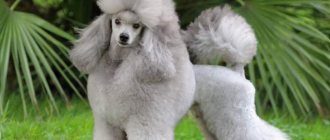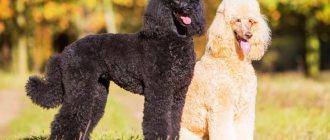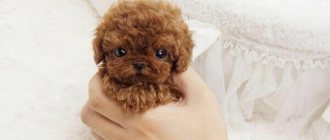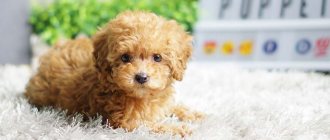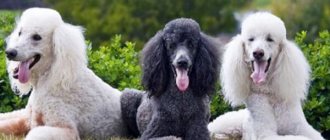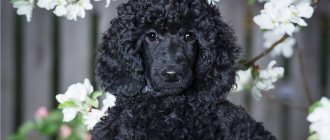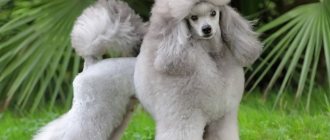The fashion for very small dogs dates back to the Middle Ages. In Western countries, such babies were companions for women. In the East, men did not disdain them either. Suffice it to recall the Pekingese, who hid in the wide sleeves of the ruler’s clothes and were a secret weapon.
Modern miniature dog breeds are companions and the best decoration. The breeding of new dwarf breeds continues. In particular, the Japanese distinguished themselves by breeding the miniature poodle . Representatives of this breed weigh only one and a half kilograms and their sizes are appropriate.
The toy poodle was bred in Japan and is now very popular in Korea and Japan.
The adorable toy poodles weigh only 1.5-3 kilograms. They look like plush toys, very funny and affectionate. The trademark of the Japanese Toy Poodle is its unusual style of poodle haircut. Babies are cut completely differently from regular larger poodles. This doll haircut with a fluffy face is called “Korean”. The small size of a dog does not mean that it can be neglected. Like all poodles, the Miniature must look perfect. With well-groomed fur, a trimmed and combed pet will become a real adornment to its owner.
How to choose a toy poodle puppy?
If you look at the websites of serious breeders, you can come up with several important rules that will help you buy a truly Japanese mini poodle.
- Contact a reputable nursery. You don’t even have to comment on this))) Lovers and fans of the breed are the best source for purchasing such an unusual breed. There they will tell you in more detail about the contents, about feeding, about the same haircut.
- Buy a Toy Poodle puppy only with a shaved face - this is the international standard for Mini Poodle show dogs. If a breeder offers a puppy with a furry face, something is wrong. If you still want to buy a mini-poodle with a “Korean” haircut, then large nurseries can cut the dog individually for you, but only upon prior request and agreement. Sometimes show puppies may not be sold if you demand a “Korean” style of haircut.
- The “Korean” style for a mini poodle is also a docked tail. Serious breeders in some cases make a concession to the buyer and buy the tail, but ask for 100% advance payment for the dog.
The cost of a Korean (Japanese) toy poodle puppy can range from 12,000 to 60,000 rubles, depending on show qualities and qualities highly valued for breeding.
How to keep a Japanese Toy Poodle?
It is believed that such dogs are great for people who suffer from allergies. Your pet should be bathed at least once a week using special products and taken regularly for haircuts. During the cold season, Japanese miniature poodles get very cold and therefore require clothing. The housewife can choose a whole wardrobe that is in harmony with her clothes.
Be sure to remember that small sizes do not make a toy out of a pet. He remains a dog who can be ill-mannered, aggressive and even bite. Training and knowledge of common commands are a must. Walking a miniature poodle is also necessary, since dogs are very active and playful. They like to run and play, rather than lie in a chair as a decorative element.
Toy poodles do not eat much, love children very much and prefer the company of their owners to that of other dogs.
Be sure to follow the rules of feeding the dog - the breeder will tell you about this. Toy poodles, like many other super-small breeds, are prone to a whole bunch of diseases associated with hair loss, internal organs and vision loss. A small dog will require a lot of careful care.
When choosing a Japanese miniature poodle as a pet, you should take into account its characteristics and inclinations. Then both the dog and the owner will be happy.
tobelady.ru
Origin history and standard
The Toy's ancestor is a large standard poodle, which gained popularity among nobles at the court of Queen Marie Antoinette of France.
The favorites of the aristocracy appeared as a result of crossing two breeds - the German shepherd (sheep poodle) and the Spanish (water poodle). They were initially considered hunting animals, but over time they began to spend more and more time at balls rather than in the swamps. Let us remember that the French lapdogs and papillons were also favorites of the French aristocracy.
Important!
Although the breed has not been around for very long, it has successfully passed the standardization procedure at the regional and international levels.
Exterior standard
FCI Standard No. 172 dated January 23, 2015 “Toy Poodle”. Group 9 “Indoor decorative dogs and companions.” Section 2 “Poodles”.
Toy poodle: the size of an adult dog is 24-28 cm in height at the withers (ideal height is 25 cm), weight no more than 3 kg.
The dwarf variety is slightly larger in size. Toy Poodle and Miniature Poodle: What's the Difference?
Attention! The Cynological Federation does not recognize any differences between them, with the exception of the height at the withers.
The dwarf poodle is taller: from 28 cm to 35 cm. The toy generally retains all the main qualities of the dwarf poodle, with the same proportions, meeting all the requirements of the standard. All signs of dwarf dwarfism (abnormal short stature) are excluded, only the occipital protuberance may be less pronounced.
In the official standard, the description of the toy poodle breed contains the following characteristics:
- Head. An elongated “fox” muzzle, smoothly descending from a narrow forehead covered with fur. Large dark nose and narrow-set dark, almost black almond-shaped eyes (interspersed with amber highlights in apricot-colored dogs).
- Ears. Strongly widening towards the bottom and rounded at the ends, hanging, flat. Completely covered with long hair in soft curls.
- Tail. They are docked in the nursery at an early age, although natural length is allowed.
- Color. Any solid color is acceptable, but clear shades are preferred.
- Addition. Proportional body, strong straight legs with well-developed muscles, good posture with a high, graceful head. The paws are small, gathered into a ball, with neat pads.
Toy poodle: a photo of an adult dog clearly demonstrates its exterior features.
How to raise and train a dog
How to raise a dog
Due to its high mental abilities, even inexperienced owners do not have problems with training. In situations where the dog stops obeying and refuses to learn, you need to entice him - to play together, give him treats or take a short break.
Attention! If self-training fails, then you should seek help from professional trainers.
Life expectancy of a toy poodle and its health
If the dog’s physical and mental health remains in order, then thanks to genetics, he is considered a long-liver. On average, a white toy poodle has a life expectancy of around 15-18 years. With proper care, the dog will grow and develop while remaining completely healthy.
How long do toy poodles live?
Toy poodle: disadvantages of the breed and positive qualities
Although the poodle is an excellent companion and, often, an assistant when hunting ducks, you should not expect guarding talents from him (if this can be called a minus).
This miniature dog is too friendly towards strangers, is not aggressive and is often cowardly. Toys can be frightened by both large adult dogs and any loud sounds or sudden movements.
Toy poodle: the disadvantages of the breed are quite capable of scaring off potential owners, but, nevertheless, they need to be understood in advance. The disadvantages include:
- unpredictability in the absence of proper upbringing (an adult can be dangerous, especially for children);
- loud and unjustified barking;
- increased morbidity - despite all the proportionality of the skeleton, this is a rather “fragile” breed;
- increased care requirements - to fully maintain an adult, a special diet, monthly haircut, and special clothing will be required;
- the need for active movement , which can be a disadvantage for a sedentary owner, because you will have to play a lot with the pet;
- a tendency to serious diseases - a high probability of developing diabetes mellitus, immune hemolytic anemia, genetically predetermined problems with the joints, epilepsy, problems with the upper respiratory tract, up to the collapse of the trachea, the risk of tooth and hair loss in old age, frequent blindness and deafness.
Focus, first of all, on people - this is the best characteristic of the Toy Poodle breed. These kids show no interest in other representatives of the dog world. Despite the significant disadvantages of nature, with proper upbringing it can become a true Friend for its owner and his family.
Additionally, check out the video about the toy poodle breed:
tvoidrug.com
The fashion for tiny dogs has been around for a long time. English queens also preferred to have such a small and picky companion who would be comfortable to carry in their arms in the company of their ladies-in-waiting. Since then, decorative dogs have become constant companions of aristocrats, the ruling elite and everyone who attends high-society parties. Although ordinary women are also not averse to having such a funny baby at home as a Chihuahua, Chin, Yorkshire Terrier or miniature Japanese Poodle.
Many dwarf dogs arose in the East, but the Japanese decided not to stop there and began to breed miniature varieties of previously known breeds. They successfully repeat the experience of American breeders, who managed to significantly reduce the size of the King Charles Spaniel, Maltese and Bichon. Our Japanese Poodle belongs to this number of small animals. Weighing only about one and a half kilograms, it can easily fit into a standard cup. With an average cost of about $5,000 per head, it is not surprising that they are among the top ten most expensive breeds.
Caring for a Japanese Poodle
Although our little pet is small in size, a tiny poodle also requires care. They also love cleanliness and need to look great. The advantage of poodles is that they hardly shed, and this will save you from constantly cleaning the carpets with vacuum cleaners. These dogs are considered to be good for people with allergies. Try to bathe your babies once a week and trim their coat on time. Otherwise, it will become tangled and your pet may experience severe discomfort. Also check your pet's ears regularly to detect possible infections early. During the cold winter months, they suffer from the cold, and it is better to find comfortable overalls or other suitable warm clothing for the animals.
You must remember that with its small size, the Japanese Miniature Poodle is still a dog that needs training, walking and love from its owner. Almost always, deterioration in a pet's health is associated with poor nutrition or lack of attention. These dogs will always prefer a walk in the park or a fun jog with you on the lawn near the house to lazy lying on a chair. Treat your baby like a little friend, despite his small size, he will also respond to you with his love and devotion.
womanadvice.ru
Interesting facts from the life of dogs
Toy poodles are incredibly smart - they are one of the top five smartest dogs in the world. Historical data confirms that the breed has enjoyed well-deserved popularity in all eras.
- The fashion for the famous lion haircut has appeared since the time of Marie Antoinette. It is believed that the Queen personally invented it for her pet. The owner dressed the dog in expensive clothes and jewelry.
- Prince Rupert of the Rhine's poodle, named Boy, was his owner's real mascot. The famous commander did not suffer a single serious defeat in battle until the dog, his constant companion, died from a bullet at the Battle of Marston Moor. Enemies considered this dog a demon helping its owner.
- In 1931, in the USA (New York), the poodle Toby became a millionaire: the deceased owner bequeathed 15 million dollars to the pet.
- Among the representatives of the breed there are many gifted actors. Dogs have often become heroes in the plots of books and films.
- Beethoven's Elegy (1787) is about the death of a poodle.
- Winston Churchill himself was a fan of this dog breed. The dog named Rufus often accompanied his owner, so his image is captured in photographs. In addition, the friends were united by a common love for chocolates.
The poodle breed is very ancient and popular at all times, so interesting facts about the life of such dogs can be cited endlessly.
Origin of the breed
It is not known for certain how the Miniature Poodle breed was formed. According to the most common version, which researchers in different countries are inclined to believe, two ancient dog breeds are related to the origin of the poodle.
One ancestor is a German shepherd dog with curly hair, the second is a “water dog” widespread in Spain, whose fur resembled cords in appearance. Both breeds were used for hunting waterfowl. The dwarf poodle dog acquired from its ancestors a unique coat, an easy-going character, an extraordinary mind and a love of water treatments.
At first, the spread of the poodle was observed in France and Belgium, later in Germany, then the breed became popular in other countries. During the 17th-18th centuries, the formation of the breed took place. To make the exterior more attractive, they were mixed with the blood of decorative dog breeds. For a long time, all small representatives of this breed were called toy poodles, without paying attention to their obvious differences. After breeders came to an agreed upon ordering of the characteristic characteristics of the breeds at the beginning of the twentieth century, miniature poodles received official recognition.
Coat type
A poodle is a dog that has quite lush and thick hair. It is considered its main advantage and makes its appearance unique. This breed of dog is characterized by two types of coat: corded and curly.
Curly wool has a fleece-like structure. It is quite dense, voluminous and lush. In addition, curly hair is highly elastic and naturally curled.
The cord coat is moderately dense, soft and fine. It forms a knitted texture in the form of countless thin cords that are located throughout the dog’s body. The average length of the cords is at least 20 cm. It is believed that the longer the dog’s cords, the higher the show potential of such a dog.
In order for the dog to always look elegant and neat, it is recommended to comb the corded coat. This should be done in such a way that the cords of wool hang evenly on both sides of the body. You can make an attractive ponytail from the hair growing above the ears and decorate it with a bow.
Characteristic features according to the standard
The first unified official breed standard was approved in 1936 in France. This main document was later adjusted, changes and additions were made to it. Today the standard published in 2007 is in force. In accordance with it, the poodle breed has:
- large;
- small;
- dwarf;
- toy poodles.
The standard requirements are the same for all types:
- Color can be brown, black, white, gray and apricot. The main requirement put forward by the standard is that the color must be solid. Slight variations in the base color are acceptable, although a clean, even color is preferred. The option does not receive confirmation of the breed if the apricot poodle has patches of brown, black or any other color in its color. The same rule applies to any other coat color: a white poodle must be exactly white, without admixtures of other colors, including those recognized as the standard - brown or gray.
- The standard head is assumed to be slightly elongated, graceful in shape, with a characteristic bump on the back of the head. The not wide forehead smoothly transitions into the muzzle, the length of which is about 90% of the entire length of the head.
- The muzzle should not be pointed. Lips are tight and dry. The nose is large and developed. The black miniature poodle and all others except the apricot poodle have exclusively black lobes. The color of the Apricot Poodle's lobe can vary from dark brown to black.
- The eyes are at the transition from the forehead to the muzzle. Black, gray and white poodles have very dark eye colors with black rims on the eyelids. The Brown Poodle has dark amber eyes with brown rims on the eyelids. The eyelids of dark apricot eyes may have brown or black edging.
- Poodle paws are strong, oval, with dense, high pads. Black and gray poodles have black claws, while brown poodles have black or brown claws. White claws are horn-colored or have pigment, even black. Apricot has brown or black claws.
- The tail is set high, and when moving it should be directed obliquely upward.
The height at the withers of adult dwarf poodles is in the range of 28-38 cm. A toy poodle is less than 28 cm; next to it, an ordinary cat often looks large. The weight of dwarfs is 12-14 kg, while that of a dwarf can weigh no more than 7.5 kg.
Description
Despite their miniature size, toy poodles exhibit harmonious proportions. When assessing a breed, the main parameters noted by the standard are checked. Dogs with symptoms of deformation changes in the bone structure are not used for breeding.
Main characteristics of the breed description:
| An object | Peculiarities |
| Head | The configuration is correct, the forehead is convex, oblong, of medium width. Cheekbones and cheeks are flattened. Prominent eye arches do not weigh down the muzzle |
| Nose | Looks flat from above. When viewed from the side it has a rectangular shape. The lobe with neat open nostrils is highlighted in black or in color to match the color |
| Jaws | Quite strong with small teeth forming a scissor bite. The adjacent thick lips are pigmented |
| Eyes | Clear, almond-shaped, shiny with densely colored eyelids |
| Ears | Elongated, rectangular in shape with rounded ends. Hanging, close to the head |
| Neck | With a slightly convex scruff, strong |
| Frame | Thanks to the straight short back, muscular lower back, rounded croup, oval chest, it is proportional |
| Tail | Set on high, docked by a third or half if necessary. When at rest it is lowered, when moving it rises obliquely upward |
| Limbs | With strong joints, smooth. The thighs are muscular, the knees are angled. Claw pads are pigmented |
Poodle nutrition
A toy poodle's diet should consist of the right foods. This is important to keep your dog healthy and active. You can feed with natural products or dry food. When feeding naturally, you need to take care of the required variety of food and include in the diet all products that saturate the dog’s body with vital vitamins and microelements. High-quality dry food itself is a ready-made, balanced mixture of all the food products a dog needs, including vitamins and microelements.
Which option to choose is up to each dog owner to decide for himself.
What to avoid in feeding:
- feed food from the table;
- allow him to feast on sweets, sausages and sausages: such food can cause serious damage to the liver, in addition, the dog gets used to begging, and it will not be easy to wean him off this;
- give your dog thick cereals, pasta and fresh baked goods: such food is poorly digested and disrupts the functioning of the gastrointestinal tract;
- mix feed from different manufacturers.
Features of care
The most important thing is caring for the dog's coat. Haircuts should be regular - once every 1.5-2 months, which depends on the rate of hair growth. Poodles do not shed; their fur must be brushed daily to prevent it from forming into lumps and tangles. To avoid this procedure, owners often choose regular short haircuts.
Miniature poodles need regular teeth cleaning and tartar removal. Another item in the regular care schedule is trimming growing nails.
Dogs of this breed often have increased eye sensitivity , so it is important to remember to clean them. The fur around the eyes also needs treatment, especially if it is light in color.
The duration of a daily walk for a miniature poodle is at least half an hour, in addition, he needs long active games.
Photo and video review
A comprehensive description of the breed will be supplemented by photos of dwarf poodles, as well as an interesting and useful video review.
Exhibition hairstyles
The haircut of a miniature poodle with which the owner plans to participate in exhibitions must be maintained in accordance with the relevant requirements, which are described in the supplement to the breed standard:
- Haircut "Lion". The name itself makes it clear that the dog will look like this huge predatory cat. To achieve this, the hair on the hind legs is trimmed down to the ribs. The front legs can be cut to the chest, but it is acceptable to leave the so-called trousers. The entire tail is trimmed, with the exception of a round or oval pompom at the very end.
- Haircut "Modern". This option is suitable for dogs of all ages and body types. An experienced groomer, when performing a haircut in this style, ensures that in the end it is possible to hide possible minor flaws in the figure and emphasize the advantages. The main idea behind this haircut is the concept of naturalness. The apparent simplicity, lightness and smoothness of lines, their proportionality and symmetry create an image of elegant, intelligent sophistication.
- Haircut "English". It is a variation of the “Lion” model, but with some differences. Flirty cuffs are left uncut on the paws, and a top note can be built on the head, but this element is not mandatory; the standard allows for its absence.
Behavior and character
The toy poodle is very attached to its owner. In the presence of the owner, the dog calmly perceives any surrounding conditions - both in a city apartment and in a country house.
The poodle has an ideal character. With proper upbringing, this dog does not bark in vain, is absolutely calm towards strangers, and accepts other pets without aggression, be it another dog, a parrot or a cat.
An intelligent dog is easy to train and enjoys participating in various active games.
5kogotkov.com
Education and training
Pets begin to be socialized from an early age. Puppies are taught to go to the toilet in a designated place and rest on a bed. Gradually, the dog is helped to master the collar and leash and is introduced to a variety of sounds.
Expert opinion
Anna Abramenko
An avid dog lover. Experience in veterinary medicine since 2009.
Ask a Question
At the first stage of raising a pet, situations that could frighten the puppy are excluded. All training actions are accompanied by soothing words and stroking the dog.
On walks, the grown toy poodle explores the territory. With proper preliminary preparation, the dog will not be afraid when he sees cars, other dogs, or a lot of people.
Smart dogs of this breed quickly remember commands. They are happy to do them if the owner is patient and follows a logical sequence when training the dog. The atmosphere should be calm, the intonation should be strict, but without shouting or threatening notes towards the pet.
Description of the Miniature Poodle dog breed
The Miniature Poodle is a type of Poodle, a dog that was originally used to hunt waterfowl. It was never possible to fully determine the exact homeland of these dogs, since they were bred in France, but their name comes from the German language. And where they originally appeared is a mystery. Based on their size, poodles are divided into four varieties, ranging from standard poodles to toy poodles. All four are considered full poodles, although they are used for different purposes.
Miniature Poodle Body Type
Dogs of this breed have thin and somewhat fragile bones, an elegant physique and undeveloped muscles. The height of these dogs ranges from 28 to 35 centimeters, and their weight is 4.5-5 kilograms. The dog has a square format, its height at the withers and the length of its back are similar in value. The back is straight and level, the stomach is tucked, the transition from the chest to the stomach is smooth but noticeable. The limbs are straight, parallel to each other, the hind limbs are spaced slightly wider than the front ones. The tail is set high, extended, not sagging or lying on the back.
The Miniature Poodle has an elongated head, tapering towards the nose, with a flat skull. The transition from the forehead to the muzzle is smooth, but noticeable, and the eyes are located strictly at the level of this transition. The ears are large, drooping and with rounded ends, located on the sides of the skull. The eyes are oval, slightly elongated. One of the key characteristics of a poodle is its intelligent look, which is something you should pay attention to. The jaws of dogs of this breed close tightly, the bite is regular, scissor-shaped.
Texture and coat color of a miniature poodle
Dogs of this breed have long, curly, soft-textured hair that requires special care. The color of the coat should be solid; spotting is considered a fault, as is brindle. The following shades are allowed by the standard: black, silver, white, brown, red and apricot. Neither variation receives an advantage in exhibitions, and they are usually judged in the same category. The color of the eyes and nose depends on the color of the coat. In black, white and silver dogs they are black. With a different color, the nose is brown, and the eyes are one shade or another of amber.
Which ones exist?
Currently, small poodle breeds include two officially recognized FCI and considered standard varieties: toy and toy.
True, especially small puppies are born, which are smaller even than standard toys. Their unofficial name is mini toy poodle. These tiny dogs are very cute, but are not allowed in shows and are not bred.
Important! Externally, all standard small varieties of poodles differ only in size; the build and shape of the head and muzzle are all the same.
The same applies to the type of coat: all these dogs, regardless of their size variety, can be either curly or corded, and any other type of coat is considered unacceptable for them. The colors allowed by the standard are also the same for all poodles.
Personality and Intelligence of the Miniature Poodle
The mini poodle is fully consistent in character and level of intelligence with its large counterpart. An obedient, intelligent dog, capable of understanding a command before the owner formulates it - this is exactly the description that suits this breed. It’s not in vain that circus performers have used these dogs for many decades. Poodles, both regular and mini, are not only beautiful and graceful. These dogs are distinguished by their agility and high level of intelligence, which makes them real super stars of the arena.
The character of a mini poodle has both positive and negative sides. If we talk about the positive aspects, then everything is simple - this dog is not only smart, it is also loyal to its owners. He fits this description - kind and affectionate, a lover of company and communication. Moreover, he loves to communicate with both people and animals. But affection and intelligence also have a downside - the poodle has a fine mental organization. In other words, he is very vulnerable and takes any punishment or neglect of his society to heart.
Possible diseases
The Miniature Poodle, like other dogs, is susceptible to a number of different diseases, the most common diseases they have are the following:
- Infringement of nerve endings caused by deformation of intervertebral discs. The causes of this disease can be various injuries of the musculoskeletal system. In severe forms, such a disease can lead to paralysis of the animal.
- Otitis, this disease due to the ears tightly fitting to the head, is quite common in the miniature poodle breed . You can tell that a pet has otitis media by its habits: it will try to scratch inside the ear, shake its head frequently, and react aggressively when pressure is applied to the ear.
- Eye diseases such as cataracts, glaucoma, and retinal erosion are usually hereditary and can appear at any age.
- Lymphadenitis, the symptoms of this disease are enlarged lymph nodes. This disease can cause overstimulation of the immune system.
- Diabetes mellitus, in a dog, the mechanism of insulin production by the pancreas may be disrupted, which in turn leads to an increase in sugar levels.
- Hypothyroidism, the symptoms of this disease are lethargy, weight gain, and skin problems in the pet. The main cause of hypothyroidism is a violation of hormonal metabolism caused by a lack of hormones in the body.
Miniature Poodle Training
A mini poodle puppy must be raised from childhood in order for the dog to fully reveal its potential. According to the standard, this breed is one of the most intelligent dog breeds. And this applies to every variety of poodle, regardless of their weight and size. The only difference in terms of training is that large poodles are trained not only for exhibitions, they are also successfully used as hunting or service dogs. But for mini poodles, the standard provides for their use only as a companion dog.
Poodles need to be trained not only because of their considerable potential, but also to correct possible character flaws. A dog that has nowhere to direct its energy and intelligence begins to destroy everything around it. And she does this only to somehow entertain herself. That is why training and education are needed, and it is advisable to train under the guidance of a professional. This way, a poodle can be weaned from bad habits such as barking at passers-by or peeling off wallpaper in the apartment.
Miniature Poodle Care
This dog can live perfectly well in a city apartment, and it can actually be toilet trained. It’s also worth purchasing toys especially for him that will keep the dog occupied if he gets bored. But it is advisable not to forget about walks, because the poodle is energetic, and he needs to spend this energy somewhere. It is enough to walk dogs of this breed twice a day, for 25-30 minutes in the morning and evening. The walk should be combined with active games. The poodle loves to fetch, so you should not play with it near the road - the dog, having forgotten itself, can jump out onto the roadway.
Poodle fur requires special care. Describing haircuts for this breed may take longer than describing the breed itself. The dog's fur is combed at least 3-4 times a week, and the poodle also needs to be bathed periodically. Representatives of this breed love water and are always happy to bathe, so there will be no problems with washing. If the owner wants his dog to become the next super star of the shows, he will have to resort to the services of professionals when it comes to cutting and preparing the coat.
Basic colors
There are a number of poodle colors that are designated by the Fédération Cynologique Internationale:
- White . Snow-white poodles are quite attractive and photogenic, but there are much more worries with an animal of this color than with all other representatives of this breed. This color option is only suitable for very clean people.
- Black . The most practical color option, since animals of this color get dirty more slowly and are quite attractive in appearance.
- Ginger . With age, the color becomes lighter. Skin color matches coat tone. The eyes are outlined in brown, the nose can be either black or brown. The eyes are brown.
- Chocolate . The coat is dark brown. The tips of the hair on the ears are lighter. The skin is identical to the tone of the coat. The lips and eyes are outlined in dark brown or black. The nose is liver colored. Eyes – rich brown or dark amber.
- Gray . A very complex color, the formation of which occurs over several years. Puppies are born black, but gradually the coat color changes. Upon reaching the age of 1.5 months, a silvery tint to the muzzle and paws can already be seen. To correctly determine the color, the animal can be shaved, then a silvery tint will be noticeable at the root. Skin tone matches coat color.
- Pink . The coat color is pale pink, matching the skin tone.
- Apricot . The wool comes in various shades of apricot, which are close to dark brown or white. The ears are slightly darker than the base color. Puppies are born with a darker color, but gradually the coat becomes lighter. Quite often this color transforms into cream. The skin is white or pink, may have gray-blue shades.
- Peach . The coat color is beige-pink. Skin tone is identical to coat color.
Miniature Poodle Health and Diseases
As with any other breed, caring for your poodle's health begins with vaccinations. The first vaccinations for puppies should be done already in the kennel, and the subsequent ones should be taken care of by the owner. The miniature poodle is not in the best health, so you should visit the veterinarian at least twice a year. In this it is inferior to varieties of the breed that exceed it in weight. Here are the diseases that most often affect miniature poodles:
- Diabetes
- Allergies (most often to polluted air or poor-quality food)
- Hearing diseases
- Vision diseases (cataracts, retinal atrophy)
- Epilepsy
- Heart muscle diseases
Currently, the Japanese miniature poodle has become popular. Many inexperienced dog breeders decided to purchase this breed. But here are the reviews experienced dog handlers leave about her:
“As such, there is no Japanese variety of poodle. The Japanese Toy Poodle is a genetic mutation, a super small dog. And the chance that she will be healthy is very small - after all, she is initially defective, from the point of view of nature. There is also a Japanese haircut method. And this is also not a separate breed - it is the same poodle, whose coat is shaped in a slightly different way.”
Choosing a Poodle Puppy
Before choosing a name for your dog, you should choose the right puppy. First you need to look at the photos that the breeder shows. Then get to know the puppy in person and see if his personality is suitable for his future owners. And after checking all the available data, you can decide whether to buy a dog. And even if the animal meets the standard, the price may vary.
A number of factors play a role here that are not visible in the photo. And which every dog owner should consider. The first factor is pedigree. A dog without hereditary diseases and with exhibition winners in its family will cost a lot. The average price of one puppy is 15-40 thousand rubles, up to 70-80 thousand for elite representatives of the breed. But it is not recommended to take an animal that is cheaper, but unhealthy physically or mentally. Such a pet will not bring joy to its owner.


